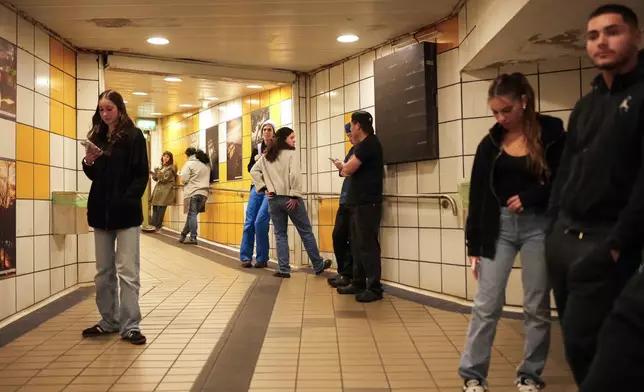A ceasefire deal that could end more than a year of cross-border fighting between Israel and Lebanon's Hezbollah militant group won backing from Israeli leaders Tuesday, raising hopes and renewing difficult questions in a region gripped by conflict.
Hezbollah leaders also signaled tentative backing for the U.S.-brokered deal, which offers both sides an off-ramp from hostilities that have driven more than 1.2 million Lebanese and 50,000 Israelis from their homes.
Click to Gallery
People take shelter in a metro station as a siren sounds a warning of incoming rockets from Lebanon in Haifa, Tuesday, Nov. 26, 2024. (AP Photo/Francisco Seco)
People take shelter in a metro station as a siren sounds a warning of incoming rockets from Lebanon in Haifa, Tuesday, Nov. 26, 2024. (AP Photo/Francisco Seco)
In this screen grab image from video provide by the Israeli Government Press Office, Israeli Prime Minister Benjamin Netanyahu makes a televised statement Tuesday, Nov. 26, 2024, in Jerusalem, Israel. (Israeli Government Press Office via AP)
Rescuers use an excavator as they search for victims at the site of an Israeli airstrike that hit a building in Beirut, Lebanon, Tuesday, Nov. 26, 2024. (AP Photo/Hassan Ammar)
Rescuers use an excavator as they search for victims at the site of an Israeli airstrike that hit a building in Beirut, Tuesday, Nov. 26, 2024. (AP Photo/Hassan Ammar)
An intense bombing campaign by Israel has killed more than 3,700 people, many of them civilians, Lebanese officials say. Over 130 people have been killed on the Israeli side.
But while the deal, set to take effect early Wednesday, could significantly calm the tensions that have inflamed the region, it does little directly to resolve the much deadlier war that has raged in Gaza since the Hamas attack on southern Israel in October 2023 that killed 1,200 people.
Hezbollah, which began firing scores of rockets into Israel the following day in support of Hamas, had previously said it would keep fighting until there was a stop to the fighting in Gaza. With the new cease-fire, it has backed away from that pledge, in effect leaving Hamas isolated and fighting a war alone.
Here’s what to know about the tentative ceasefire agreement and its potential implications:
The agreement reportedly calls for a 60-day halt in fighting that would see Israeli troops retreat to their side of the border while requiring Hezbollah to end its armed presence in a broad swath of southern Lebanon. President Joe Biden said Tuesday that the deal is set to take effect at 4 a.m. local time on Wednesday (9 p.m. EST Tuesday).
Under the deal, thousands of Lebanese troops and U.N. peacekeepers are to deploy to the region south of the Litani River. An international panel lead by the U.S. would monitor compliance by all sides. Biden said the deal “was designed to be a permanent cessation of hostilities.”
Israel has demanded the right to act should Hezbollah violate its obligations. Lebanese officials have rejected writing that into the proposal. Israeli Prime Minister Benjamin Netanyahu said Tuesday that the military would strike Hezbollah if the U.N. peacekeeping force, known as UNIFIL, does not enforce the deal.
A Hezbollah leader said the group's support for the deal hinged on clarity that Israel would not renew its attacks.
“After reviewing the agreement signed by the enemy government, we will see if there is a match between what we stated and what was agreed upon by the Lebanese officials,” Mahmoud Qamati, deputy chair of Hezbollah’s political council, told the Qatari satellite news network Al Jazeera.
“We want an end to the aggression, of course, but not at the expense of the sovereignty of the state” of Lebanon, he said.
The European Union’s top diplomat, Josep Borrell, said Tuesday that Israel’s security concerns had been addressed in the deal, also brokered by France. Hezbollah indicated it would give the ceasefire pact a chance.
After months of cross-border bombings, Israel can claim major victories, including the killing of Hezbollah’s top leader, Hassan Nasrallah, most of his senior commanders and the destruction of extensive militant infrastructure.
A complex attack in September involving the explosion of hundreds of walkie-talkies and pagers used by Hezbollah was widely attributed to Israel, signaling a remarkable penetration of the militant group.
The damage inflicted on Hezbollah has come not only in its ranks, but to the reputation it built by fighting Israel to a stalemate in the 2006 war. Still, its fighters managed to put up heavy resistance on the ground, slowing Israel’s advance while continuing to fire scores of rockets, missiles and drones across the border each day.
The ceasefire offers relief to both sides, giving Israel’s overstretched army a break and allowing Hezbollah leaders to tout the group’s effectiveness in holding their ground despite Israel’s massive advantage in weaponry. But the group is likely to face a reckoning, with many Lebanese accusing it of tying their country’s fate to Gaza’s at the service of key ally Iran, inflicting great damage on a Lebanese economy that was already in grave condition.
Until now, Hezbollah has insisted that it would only halt its attacks on Israel when it agreed to stop fighting in Gaza. Some in the region are likely to view a deal between the Lebanon-based group and Israel as a capitulation.
In Gaza, where officials say the war has killed more than 44,000 Palestinians, Israel’s attacks have inflicted a heavy toll on Hamas, including the killing of the group’s top leaders. But Hamas fighters continue to hold scores of Israeli hostages, giving the militant group a bargaining chip if indirect ceasefire negotiations resume.
Hamas is likely to continue to demand a lasting truce and a full Israeli withdrawal from Gaza in any such deal, while Netanyahu on Tuesday reiterated his pledge to continue the war until Hamas is destroyed and all hostages are freed.
Palestinian Authority President Mahmoud Abbas, whose forces were ousted from Gaza by Hamas in 2007 and who hopes to one day rule over the territory again as part of an independent Palestinian state, offered a pointed reminder Tuesday of the intractability of the war, demanding urgent international intervention.
“The only way to halt the dangerous escalation we are witnessing in the region, and maintain regional and international stability, security and peace, is to resolve the question of Palestine,” he said in a speech to the U.N. read by his ambassador.

People take shelter in a metro station as a siren sounds a warning of incoming rockets from Lebanon in Haifa, Tuesday, Nov. 26, 2024. (AP Photo/Francisco Seco)

People take shelter in a metro station as a siren sounds a warning of incoming rockets from Lebanon in Haifa, Tuesday, Nov. 26, 2024. (AP Photo/Francisco Seco)

In this screen grab image from video provide by the Israeli Government Press Office, Israeli Prime Minister Benjamin Netanyahu makes a televised statement Tuesday, Nov. 26, 2024, in Jerusalem, Israel. (Israeli Government Press Office via AP)

Rescuers use an excavator as they search for victims at the site of an Israeli airstrike that hit a building in Beirut, Lebanon, Tuesday, Nov. 26, 2024. (AP Photo/Hassan Ammar)

Rescuers use an excavator as they search for victims at the site of an Israeli airstrike that hit a building in Beirut, Tuesday, Nov. 26, 2024. (AP Photo/Hassan Ammar)
President-elect Donald Trump will return to power next year with a raft of technological tools at his disposal that would help deliver his campaign promise of cracking down on immigration — among them, surveillance and artificial intelligence technology that the Biden administration already uses to help make crucial decisions in tracking, detaining and ultimately deporting immigrants lacking permanent legal status.
While immigration officials have used the tech for years, an October letter from the Department of Homeland Security obtained exclusively by The Associated Press details how those tools — some of them powered by AI — help make decisions over whether an immigrant should be detained or surveilled.
One algorithm, for example, ranks immigrants with a “Hurricane Score,” ranging from 1-5, to assess whether someone will “abscond” from the agency's supervision.
The letter, sent by DHS Chief Artificial Intelligence Officer Eric Hysen to the immigrant rights group Just Futures Law, revealed that the score calculates the potential risk that an immigrant — with a pending case — will fail to check in with Immigration and Customs Enforcement officers. The algorithm relies on several factors, he said, including an immigrant’s number of violations and length of time in the program, and whether the person has a travel document. Hysen wrote that ICE officers consider the score, among other information, when making decisions about an immigrant’s case.
“The Hurricane Score does not make decisions on detention, deportation, or surveillance; instead, it is used to inform human decision-making,” Hysen wrote.
Also included in the government’s tool kit is a mobile app called SmartLINK that uses facial matching and can track an immigrant’s specific location.
Nearly 200,000 people without legal status who are in removal proceedings are enrolled in the Alternatives to Detention program, under which certain immigrants can live in the U.S. while their immigration cases are pending.
In exchange, SmartLINK and GPS trackers used by ICE rigorously surveil them and their movements. The phone application draws on facial matching technology and geolocation data, which has been used before to find and arrest those using the app.
Just Futures Law wrote to Hysen earlier this year, questioning the fairness of using an algorithm to assess whether someone is a flight risk and raising concerns over how much data SmartLINK collects. Such AI systems, which score or screen people, are used widely but remain largely unregulated even though some have been found to discriminate on race, gender or other protected traits.
DHS said in an email that it is committed to ensuring that its use of AI is transparent and safeguards privacy and civil rights while avoiding biases. The agency said it is working to implement the Biden administration’s requirements on using AI, but Hysen said in his letter that security officials may waive those requirements for certain uses. Trump has publicly vowed to repeal Biden's AI policy when he returns to the White House in January.
“DHS uses AI to assist our personnel in their work, but DHS does not use the outputs of AI systems as the sole basis for any law enforcement action or denial of benefits,” a spokesperson for DHS told the AP.
Trump has not revealed how he plans to carry out his promised deportation of an estimated 11 million people living in the country illegally. Although he has proposed invoking wartime powers, as well as military involvement, the plan would face major logistical challenges — such as where to keep those who have been detained and how to find people spread across the country — that AI-powered surveillance tools could potentially address.
Karoline Leavitt, a spokesperson for Trump, did not answer questions about how the incoming administration plans to use DHS’ tech, but said in a statement that “President Trump will marshal every federal and state power necessary to institute the largest deportation operation” in American history.
Over 100 civil society groups sent a letter on Friday urging the Office of Management and Budget to require DHS to comply with the Biden administration’s guidelines. A spokesperson for OMB said that agencies must align their AI tools with the guidelines by December 1, and that any extensions or waivers of that deadline will be publicly disclosed next month.
Just Futures Law’s executive director, Paromita Shah, said if immigrants are scored as flight risks, they are more likely to remain in detention, "limiting their ability to prepare a defense in their case in immigration court, which is already difficult enough as it is.”
SmartLINK, part of the Intensive Supervision Appearance Program, is run by BI Inc., a subsidiary of the private prison company The GEO Group. The GEO Group also contracts with ICE to run detention centers.
ICE is tight-lipped about how it uses SmartLINK’s location feature to find and arrest immigrants. Still, public records show that during Trump’s first term in 2018, Manassas, Virginia-based employees of BI Inc. relayed immigrants’ GPS locations to federal authorities, who then arrested over 40 people.
In a report last year to address privacy issues and concerns, DHS said that the mobile app includes security features that “prohibit access to information on the participant’s mobile device, with the exception of location data points when the app is open.”
But the report notes that there remains a risk that data collected from people "may be misused for unauthorized persistent monitoring.”
Such information could also be stored in other ICE and DHS databases and used for other DHS mission purposes, the report said.
On investor calls earlier this month, private prison companies were clear-eyed about the opportunities ahead.
The GEO Group’s executive chairman George Christopher Zoley said that he expects the incoming Trump administration to “take a much more aggressive approach regarding border security as well as interior enforcement and to request additional funding from Congress to achieve these goals.”
“In GEO’s ISAP program, we can scale up from the present 182,500 participants to several hundreds of thousands, or even millions of participants,” Zoley said.
That same day, the head of another private prison company told investors he would be watching closely to see how the new administration may change immigrant monitoring programs.
“It’s an opportunity for multiple vendors to engage ICE about the program going forward and think about creative and innovative solutions to not only get better outcomes, but also scale up the program as necessary,” Damon Hininger, CEO of the private prison company CoreCivic Inc. said on an earnings call.
GEO did not respond to requests for comment. In a statement, CoreCivic said that it has played “a valued but limited role in America’s immigration system” for both Democrats and Republicans for over 40 years.

FILE - Chinese migrants wait to be processed after crossing the border with Mexico May 8, 2024, near Jacumba Hot Springs, Calif. (AP Photo/Ryan Sun, File)

FILE - Border Patrol agents talk with migrants seeking asylum as they prepare them for transportation to be processed, June 5, 2024, near Dulzura, Calif. (AP Photo/Gregory Bull, File)





















